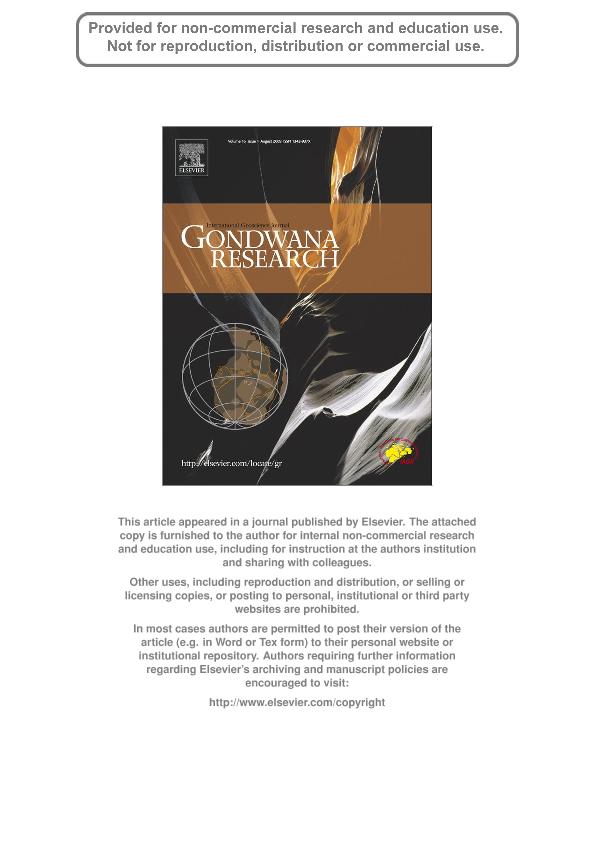Mostrar el registro sencillo del ítem
dc.contributor.author
Sánchez Betucci, Leda
dc.contributor.author
Koukharsky, Magdalena Maria L.

dc.contributor.author
Pazos, Pablo Jose

dc.contributor.author
Stareczek, Santiago
dc.date.available
2019-11-21T14:58:31Z
dc.date.issued
2009-08
dc.identifier.citation
Sánchez Betucci, Leda; Koukharsky, Magdalena Maria L.; Pazos, Pablo Jose; Stareczek, Santiago; Neoproterozoic subaqueous extrusive-intrusive rocks in the Playa Hermosa Formation in Uruguay: Regional and stratigraphic significance; Elsevier Science; Gondwana Research; 16; 1; 8-2009; 134-144
dc.identifier.issn
1342-937X
dc.identifier.uri
http://hdl.handle.net/11336/89383
dc.description.abstract
Volcanic rocks in southern Uruguay are linked to an extensional tectonic regime related to the post-collisional Brasiliano-Pan African orogenic cycle. The ca 580 Ma magmatic event is recorded in the Playa Hermosa Formation. In the upper section of this formation several units were defined. The basal unit is a quartz-syenite brecciated deposit, interpreted as the result of explosive episodes of shallow plutonic quartz-syenite intrusion with signs of hydrothermal alteration. Sedimentary and basaltic lithoclasts are occasionally present in the breccia, implying the emplacement of basalts before of that magmatic event. The middle unit is composed of trachytic hyaloclastites. Local distribution and textural evidence indicate that trachytic volcanic pulses have been followed by an explosive event that produced brecciated deposits. The upper unit of the studied sequence is composed of basalts with thin sedimentary intercalations. Most of the outcropping basalts display the typical micro- and macro-features of hyaloclastites; distinctive of extrusions occurred in wet sediments previous to lithification. Basaltic feeder dikes are common in the lower unit. The study of flow structures in the quartz-syenite brecciated deposits led to the recognition of two basaltic inputs. Such differences are related to the intensity of chloritic alteration, which would be related to water contamination. Basaltic peperites are one of the most impressive features of the Playa Hermosa Formation. Hyaloclastites and peperites largely represented among the studied volcanic rocks, and devitrification textures are all evidences of magma/seawater interactions. In the basaltic fragments of the peperites well preserved orange palagonite appears, while the sandstone fractions have lithic clasts of felsic volcanic rocks, such as rhyolitic lavas with perlitic cracks and lithophysae-like structures. Palagonite chemical analyses suggest marine environment and, at the same time, it proves that the studied section lacks of regional metamorphism. The felsic volcanic lithoclasts contained in sandstones could be related to the felsic volcanic lobes intercalations. The studied magmatic event is important in order to formulate correlations with other Neoproterozoic units distributed around the Dom Feliciano belt, like Camaquã and Campo Alegre basins (Brazil), and in the Kaoko belt (NW Namibia) in Africa. Also, Playa Hermosa Formation presents glacigenic features that are well documented, and reinforce the volcanism around 580 Ma in the Rio de la Plata Craton.
dc.format
application/pdf
dc.language.iso
eng
dc.publisher
Elsevier Science

dc.rights
info:eu-repo/semantics/openAccess
dc.rights.uri
https://creativecommons.org/licenses/by-nc-sa/2.5/ar/
dc.subject
NEOPROTEROZOIC
dc.subject
PEPERITES
dc.subject
PLAYA HERMOSA FORMATION
dc.subject
QUARTZ-SYENITE BRECCIA
dc.subject
URUGUAY
dc.subject.classification
Geología

dc.subject.classification
Ciencias de la Tierra y relacionadas con el Medio Ambiente

dc.subject.classification
CIENCIAS NATURALES Y EXACTAS

dc.title
Neoproterozoic subaqueous extrusive-intrusive rocks in the Playa Hermosa Formation in Uruguay: Regional and stratigraphic significance
dc.type
info:eu-repo/semantics/article
dc.type
info:ar-repo/semantics/artículo
dc.type
info:eu-repo/semantics/publishedVersion
dc.date.updated
2019-10-10T19:32:44Z
dc.journal.volume
16
dc.journal.number
1
dc.journal.pagination
134-144
dc.journal.pais
Países Bajos

dc.journal.ciudad
Amsterdam
dc.description.fil
Fil: Sánchez Betucci, Leda. Universidad de la República; Uruguay
dc.description.fil
Fil: Koukharsky, Magdalena Maria L.. Consejo Nacional de Investigaciones Científicas y Técnicas; Argentina. Universidad de Buenos Aires. Facultad de Ciencias Exactas y Naturales; Argentina
dc.description.fil
Fil: Pazos, Pablo Jose. Consejo Nacional de Investigaciones Científicas y Técnicas. Oficina de Coordinación Administrativa Ciudad Universitaria. Instituto de Estudios Andinos "Don Pablo Groeber". Universidad de Buenos Aires. Facultad de Ciencias Exactas y Naturales. Instituto de Estudios Andinos "Don Pablo Groeber"; Argentina
dc.description.fil
Fil: Stareczek, Santiago. Universidad de la República; Uruguay
dc.journal.title
Gondwana Research

dc.relation.alternativeid
info:eu-repo/semantics/altIdentifier/url/https://www.sciencedirect.com/science/article/pii/S1342937X09000033
dc.relation.alternativeid
info:eu-repo/semantics/altIdentifier/doi/http://dx.doi.org/10.1016/j.gr.2009.01.002
Archivos asociados
